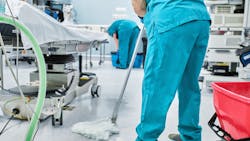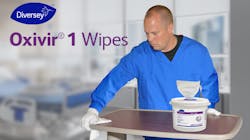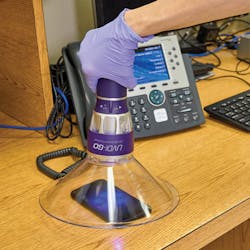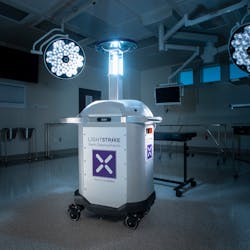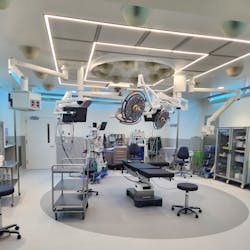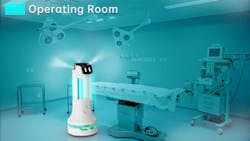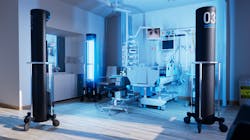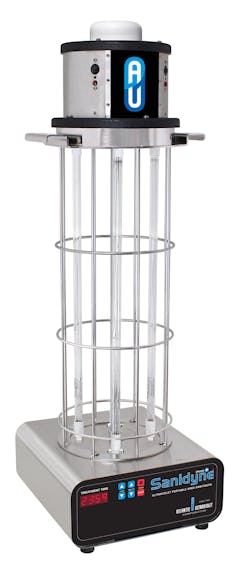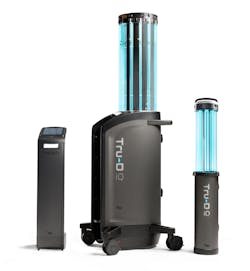Room Decontamination Challenges Remain High Post-COVID
Despite years of progress in reducing healthcare associated infections (HAIs), research from The Leapfrog Group found the average risk of three HAIs - Methicillin-resistant Staphylococcus aureus (MRSA), central line-associated bloodstream infections (CLABSI) and catheter-associated urinary tract infections (CAUTI) - “spiked to a five-year high in hospitals during the COVID-19 pandemic and remain high.”1
Researchers in a recent Intensive and Critical Care Nursing journal article noted how patients in intensive care units (ICUs) are at high risk for HAIs “due to the high prevalence of invasive procedures and devices, induced immunosuppression, comorbidity, frailty, and increased age.” They explained that while there has been a “successful reduction in the incidence of HAIs related to invasive procedures and devices…the rate of ICU-acquired infections remains high.” The researchers also warned how “the ongoing emergence of new pathogens, further complicates treatment and threatens patient outcomes.”2
In a 2023 AORN Journal article on preventing surgical site infections (SSI), researchers noted how “Preventing and reducing SSIs requires a multifaceted approach encompassing the continuum of medical and surgical care.”3
Given the importance of protecting patients in perioperative and critical care spaces from potentially dangerous microorganisms and subsequent infections, HPN has gathered the following best practices in room decontamination from suppliers of equipment and technology in this area.
Preparing for pathogen warfare
“It is key to simplify and have a playbook for this with the products, procedures and training for staff to be able to do the job well,” said Becker. “Both thoroughness and frequency of cleaning and disinfection are key to outcomes.” Becker offered these three best practices for healthcare facilities to include in their environmental hygiene playbooks:
- Clearly defined roles and responsibilities: A checklist of all surfaces, equipment, and areas to be cleaned and disinfected, along with who, when, and how often these tasks are to be performed is key to ensuring staff members understand their role. Well-defined procedures should be in place outlining how to effectively complete these tasks along with tools to reinforce learning.
- Having the right tools to drive compliance and efficiency: Products and tools that get the job done faster (dwell times, fewer steps) can drive compliance and efficiency. To ensure cleaning compliance of high-touch surfaces, products selected should be non-irritating and pleasant for the patient, and safe for use by staff.
- Deploying a validation program with ongoing training to address areas of opportunity: If cleaning and disinfection compliance are important, they need to be measured. A measurement program to ensure the job is getting done correctly will contribute to success.
McLean recommends healthcare facilities take the three following steps in their disinfection plan development:
- Identify areas to be disinfected by assessing the risk level for pathogen transmission. For example, the risk of contracting C. diff increases 2.5x for patients assigned to rooms previously occupied by a C. diff patient.6
- Outline when the surfaces within those areas should be disinfected, how, and by whom. Start with highest-risk areas and move to lower-risk areas. Using tools, like a checklist, can also be beneficial in ensuring proper protocols are followed.
- Employ ready-to-use, bleach-based products in high-risk areas, like perioperative rooms, for maximum efficiency and efficacy against hard-to-kill pathogens like C. diff and C. auris.
Combatting microbes on the move
“Microorganisms may persist on medical equipment surfaces, on the environment surrounding patients, and on corporal surfaces of patients and healthcare workers (HCWs).”7 Because the patient care environment is not static, when people or equipment are moved from room to room, there is the risk for contamination spread.
“It can be challenging to clean and disinfect items during a shift and day,” Gerard asserted. “It is important to first review the peer-reviewed, published literature to identify potentially high-risk surfaces and equipment that you want to target in your specific patient environment.”
Once stakeholders have compiled their list of target areas to address, Gerard recommends they select surface disinfection product(s) to use. He offered the following criteria for healthcare professionals to consider in assessing and selecting a surface disinfection product or technology:
- Efficacy: what microorganisms is it independently proven to disinfect?
- Workflow fit: how quickly can the product be used or operated without disrupting your fast-paced workflow?
- User and surface safety: what personal protective equipment (PPE) is required by the manufacturer? Is the product safe to use on the desired surface(s)? For example, touchscreens are becoming more prevalent in the healthcare environment and some products will damage or discolor them.
Disinfecting between cases
Simmons pointed to “pulsed xenon UV disinfection robots” as a solution that “can deliver rapid microbial reduction in just two minutes, targeting pathogens that may be on the surgical table and anesthesia machine.”
When implementing a UV disinfection program, Simmons said many hospitals choose critical care for the initial roll-out. She adds that while targeting a specific unit is a best practice, this approach “can sometimes fall short when only isolation rooms on the target unit are selected for disinfection.”
Simmons explained, “Some patients may not be on isolation precautions but may be infected or colonized with drug-resistant bacteria that have yet to be identified in their clinical course of care. The best practice for utilizing UV robots on the unit would be to treat every room regardless of isolation status at patient discharge. This would assure a uniform standard of care for all patients, and is the best method for systematically bringing down bioburden on the unit.”
According to Steven Baiocchi, Chief Operating Officer, Steriliz, the use of fixed UVC light systems, as an adjunct to quick manual wipe downs between cases, helps address aerosolization of very small, fine droplets and particles – containing infectious viruses that are released into the air as a result of medical procedures.
“Pathogen-specific cycles may be programmed to target life-threatening pathogens, including COVID-19, MRSA, C. diff., and more,” he added. “Wall/ceiling installation reduces shadowed areas, yielding higher efficacy than point-source portable systems so treatment time is exact and real-time proof of compliance information is captured via disinfection tracking software.”
Launching a multi-mode attack on germs
“The CDC reported the pandemic set progress back a decade, causing the first increase in HAIs reported since 2015,” said Amy Carenza, Chief Commercial Officer, ActivePure. She cited research that reveals several current gaps in cleaning and disinfection protocols:
- Missed areas: 50% of targeted touch points are missed by manual cleaning and disinfection, and 40% of those cleaned have been deemed inadequately disinfected. Further research emphasizes the need to target non-high touch points as risks of infection come from everywhere, including floors.8
- Recontamination: Studies have shown how rapidly high-touch sites are re-contaminated immediately after episodic cleaning and disinfection.9
- Aerosolization: The recent pandemic and emerging pathogens like C. auris highlight the undeniable risks from airborne pathogens and the necessity of continuous and persistent remediation.10, 11, 12
Gerald Prall, Chief Sales Officer, Pringle Robotics, added, “Best practices for decontaminating sensitive perioperative and critical care spaces should include using all tools in the technological arsenal to disinfect to the highest possible standard. Following up traditional frontline electrostatic spraying and hand-wiping methods with UV-C and ultrasonic dry mist disinfection technology rounds out infection control procedures and leaves less room for error.”
Prall noted how UV-C light systems have been proven, in both lab and real-world scenarios, to have strong pathogen inactivation efficacy. “They reach surface areas that can be missed by hand-wiping and electrostatic spray systems,” he explained. “Likewise, ultrasonic dry mist systems produce disinfectant particles of such small size that surfaces are more easily coated, and drying is instantaneous.”
When used together, combination UV-C and dry mist disinfection systems are becoming a “gold standard in sanitization and infection control” according to Prall. He said new autonomous combination UV-C and dry mist systems can “provide high-efficacy disinfection without much in the way of staff involvement, providing a type of automated fail-safe to human-powered cleaning methods.”
Gunner Lyslo, Founder and CEO of Surfacide, explained how UV-C disinfection technology can complement existing cleaning protocols in hospitals to provide an added layer of protection against bacteria, viruses, and some spores in patient rooms, as well as high-risk areas like perioperative, ICUs, ORs and burn units.
Lyslo concluded, “As hard as environmental services teams work daily, the pandemic accelerated and highlighted the critical importance of adjunctive disinfection solutions, like UV-C, for the environment. Given data that discuss more than 50% of surfaces are not cleaned during the terminal cleaning process, people’s awareness of cleanliness and the need for innovative disinfection solutions has continued to be so important.” 13
Boehme continued, “Direct UV-C Sanitizers (with UV-C lamps visible) must only be operated in unoccupied rooms with danger signs posted at all entrances. While germicidal UV light is lethal to bacteria and viruses, it is also harmful to eyes and skin. When determining the appropriate treatment time for your room size, take note of a fixture’s UV output, and what microorganism(s) you want to inactivate. Due to their ability to directly expose air and surfaces to the appropriate UV-C wavelengths, these sanitizers are essential for critical care units. Consult an ultraviolet specialist who can help you figure out which sanitizer is best for your application.”
References
1. New Leapfrog Hospital Safety Grade Reveals Significant Increase in Healthcare-Associated Infections and Worsening Patient Experience during COVID-19 Pandemic, The Leapfrog Group, May 3, 2023, https://www.leapfroggroup.org/news-events/new-leapfrog-hospital-safety-grade-reveals-significant-increase-healthcare-associated
2. Blot S, Ruppé E, Harbarth S, Asehnoune K, Poulakou G, Luyt CE, Rello J, Klompas M, Depuydt P, Eckmann C, Martin-Loeches I, Povoa P, Bouadma L, Timsit JF, Zahar JR. Healthcare-associated infections in adult intensive care unit patients: Changes in epidemiology, diagnosis, prevention and contributions of new technologies. Intensive Crit Care Nurs. 2022 Jun;70:103227. doi: 10.1016/j.iccn.2022.103227. Epub 2022 Mar 3. PMID: 35249794; PMCID: PMC8892223.
3. Rosa R, Sposato K, Abbo LM. Preventing Surgical Site Infections: Implementing Strategies throughout the Perioperative Continuum. AORN J. 2023 May;117(5):300-311. doi: 10.1002/aorn.13913. PMID: 37102746.
4. Kramer A, Schwebke I, Kampf G. How long do nosocomial pathogens persist on inanimate surfaces? A systematic review. BMC Infect. Dis. 2006; 6:130.
5. Chin AWH et al. Stability of SARS-CoV-2 in different environmental conditions. Lancet [Internet]. April 2020 [cited July 13, 2023]. Available From: https://www.thelancet.com/action/showPdf?pii=S2666-5247%2820%2930003-3
6. Chemaly RF, Simmons S, Dale C, Shashank G, Rodriguez M, Gubb J, et al. The role of the healthcare environment in the spread of multidrug-resistant organisms: update on current best practices for containment. Therapeutic Advances in Infectious Disease. 2014;2(3-4):79-90.
7. Cruz-López F, Martínez-Meléndez A, Garza-González E. How Does Hospital Microbiota Contribute to Healthcare-Associated Infections? Microorganisms. 2023 Jan 12;11(1):192. doi: 10.3390/microorganisms11010192. PMID: 36677484; PMCID: PMC9867428.
8. Jinadatha C, Villamaria FC, Coppin JD, Dale CR, Williams MD, Whitworth R, Stibich M. Interaction of healthcare worker hands and portable medical equipment: a sequence analysis to show potential transmission opportunities. BMC Infect Dis. 2017 Dec 28;17(1):800. doi: 10.1186/s12879-017-2895-6. PMID: 29281998; PMCID: PMC5745722.
9. Sansom, S., Gussin, G., Singh, R., Bell, P., Jinal, E., Makhija, Hayden, M. (2022). Multicenter evaluation of contamination of the healthcare environment near patients with Candida auris skin colonization. Antimicrobial Stewardship & Healthcare Epidemiology, 2(S1), S78-S79. doi:10.1017/ash.2022.205
10. Lidia Morawska, Donald K Milton, It Is Time to Address Airborne Transmission of Coronavirus Disease 2019 (COVID-19), Clinical Infectious Diseases, Volume 71, Issue 9, 1 November 2020, Pages 2311–2313, https://doi.org/10.1093/cid/ciaa939
11. Scientific Brief: SARS-CoV-2 Transmission, CDC, May 7, 2021, https://www.cdc.gov/coronavirus/2019-ncov/science/science-briefs/sars-cov-2-transmission.html
12. Najeeb H, Siddiqui SA, Anas Z, Ali SH, Usmani SUR, Jawed F, Jatoi HN. The Menace of Candida auris Epidemic amidst the COVID-19 Pandemic: A Systematic Review. Diseases. 2022 Aug 29;10(3):58. doi: 10.3390/diseases10030058. PMID: 36135214; PMCID: PMC9497911.
13. https://static1.squarespace.com/static/5fdd31e1a560fe4c1d093c75/t/639cc68db1d7df63551893b8/1671218829768/Boyce+et+al.+2009.pdf
Sarasota Memorial’s Extra Layer of Clean
“We received positive feedback from staff who had hands-on experience with it,” said Natasha Pabon, Operations Manager, Environmental Services (EVS) for Sarasota Memorial Health Care System. “At our facility, EVS leaders became trainers right away. It’s easy to use, so training times are expected to decrease.”
Training took 10-15 minutes for experienced operators, and it is expected to take roughly 20-25 minutes for new operators.
Because the new system directs excess energy in the direction of lower-dose sensors, less energy is wasted where it is not needed, and cycle times are reduced. For Sarasota Memorial Hospital, cycle times were significantly reduced compared to their previous UV-C disinfection technology – often 30%-50% faster on both cycle types (maximum and efficiency).
While the EVS team still cleans each room by hand, in higher-risk areas they employ the UV-C disinfection technology “to guarantee an extra layer of clean,” said Greg Rosenberger, former Director of Hospitality Services at Sarasota Memorial Hospital, who oversaw the hospital’s EVS team until May 2023.
About the Author
Kara Nadeau
Senior Contributing Editor
Kara Nadeau is Sterile Processing Editor for Healthcare Purchasing News.
